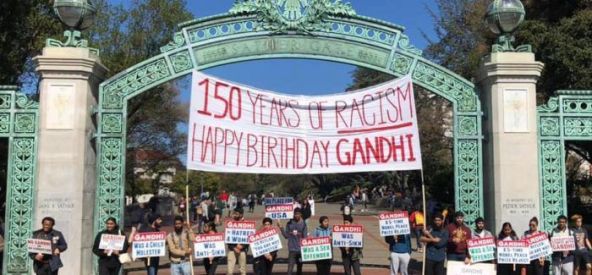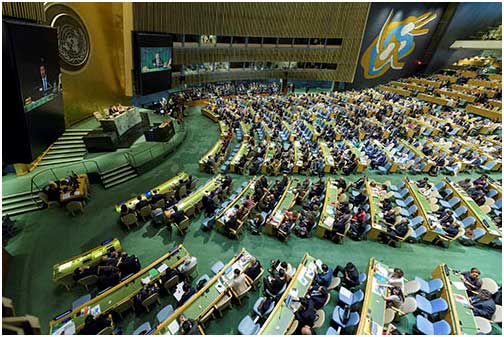
- By a Staff Writer India Abroad Oct 5, 2019

As celebrations across the country marked the 150th birth anniversary of Mohandas Karamchand Gandhi, Oct. 2, several groups demonstrated against the Mahatma.
According to a press release issued by the Organization for Minorities of India (OFMI), protestors accused Gandhi of racism and displayed placards calling him the “father of apartheid.” Other placards claimed Gandhi hated women and stated that “Gandhi was a sex offender.”
At the Martin Luther King, Jr. Center in Atlanta, Georgia, a group including several African-Americans demanded removal of the Gandhi statue placed at the center, the OFMI said.
Jerry Jones, an OFMI activist, displayed placards declaring: “No place for Gandhi in USA.” Another placard held by Jones quoted South African author Ashwin Desai, who stated, “Gandhi believed in the Aryan brotherhood. This involved whites and Indians higher up than Africans on the civilized scale.”
Demonstrators later moved to Georgia State University to protest a commemoration of Gandhi hosted by the Consulate General of India in Atlanta in collaboration with the Gandhi Foundation of USA.
Earlier, on Sept. 24, according to the OFMI press release, Jones and Nanak Singh represented the group at the Gwinnet County Board of Commissioners’ public hearing, “where they appeared to register dissent” against a proposed bust of Gandhi which the county was planning to unveil at Bryson Park, Lilburn, Georgia, Oct. 12.
“There is no way there should be statues erected commemorating a man who could not stand Africans,” the OFMI press release quoted Cheryle Renee Moses, the Democratic nominee for Georgia State Senate’s District 9 in Gwinnett County as saying. “I’m sure many other African-Americans and black folks would feel the same way once they are educated on Gandhi’s real beliefs about Africans, about black folks,” she said.
Similarly, on the West Coast, approximately 20 people blocked the Sather Gate at University of California, Berkeley, Oct. 2. Holding a large banner declaring, “150 Years of Racism: Happy Birthday, Gandhi,” they chanted slogans such as “Down with Gandhi” and delivered short speeches about why they were protesting Gandhi.
“Gandhi is used as a diplomatic weapon by the Indian State,” said Bhajan Singh, a former director of OFMI. He claimed that the Government of India has expanded its budget to finance Gandhi statues around the world, adding, “They have occupied Kashmir, they have attacked the Sikhs in Punjab, they have attacked Dalits, Christians, and they want to forcefully convert and submerge the traditional Dravidian culture of India into the pro-Aryan culture.”
Although Gandhi is widely perceived as a “Mahatma” (Great Soul) and portrayed as an icon of peace, the past several years have brought increased calls for reevaluation of his legacy. In 2014, protests erupted over a proposed statue of Gandhi in London after historian Kusoom Vadgama began a petition alleging that the Indian activist “dishonored women.” In 2018, a Gandhi statue was removed from the University of Ghana campus after students and faculty began a petition against Gandhi’s “racist identity.” An ongoing campaign against a proposed statue of Gandhi in Malawi has generated almost 4,300 signatures on a petition calling him an “ardent racist.”
“Modi’s years of building upon the false Gandhi propaganda to support the goals of India’s Hindu nationalist movement are being challenged around the world,” Arvin Valmuci of the OFMI said.


